Homelessness in Australia: Causes, Costs, and Government Initiatives
VerifiedAdded on 2021/12/15
|8
|1589
|55
Report
AI Summary
This report delves into the multifaceted issue of homelessness in Australia, providing a comprehensive analysis of its causes and associated costs. It identifies factors such as poverty, mental illness, and lack of social support as key contributors to homelessness, highlighting the significant financial burden it places on the government. The report then examines the Australian government's initiatives to address homelessness, including The Road Home Scheme, which aimed to reduce homelessness through early intervention and service expansion. It also discusses the implementation of affordable housing programs, national partnerships to prevent homelessness, and state government initiatives like hospital liaison services and the Ask Izzy website. The report concludes by emphasizing the importance of collaboration between government and civil society organizations to effectively address and rehabilitate individuals experiencing homelessness.
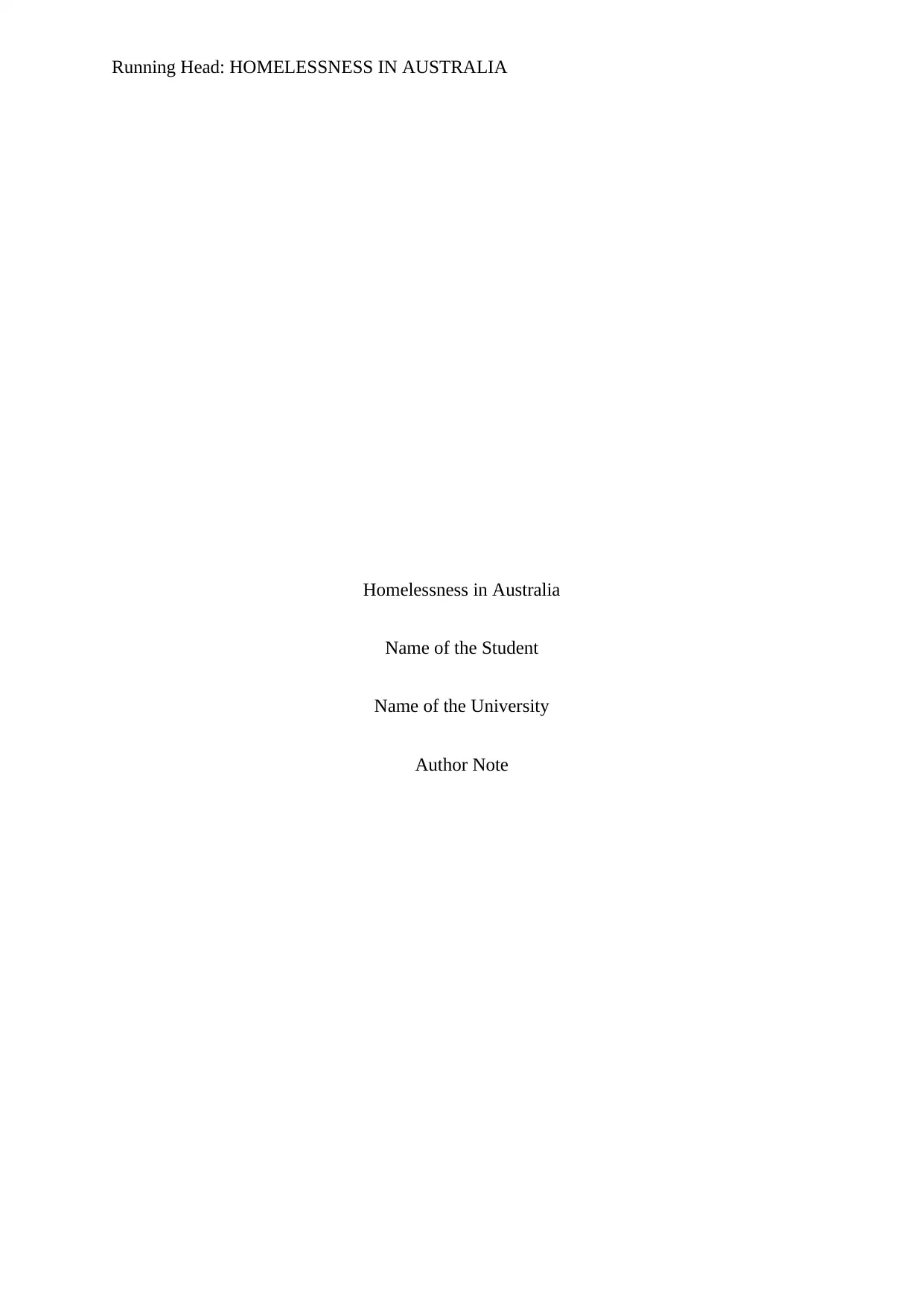
Running Head: HOMELESSNESS IN AUSTRALIA
Homelessness in Australia
Name of the Student
Name of the University
Author Note
Homelessness in Australia
Name of the Student
Name of the University
Author Note
Paraphrase This Document
Need a fresh take? Get an instant paraphrase of this document with our AI Paraphraser

1HOMELESSNESS IN AUSTRALIA
Table of Contents
Introduction................................................................................................................................2
1. Causes and Cost of Homelessness in Australia..................................................................2
2. Government Response to Homelessness in Australia.........................................................2
2.1. The Road to Home Scheme.........................................................................................2
2.2. Affordably Priced Housing..........................................................................................3
2.3. National Government Partnership to Prevent Homelessness......................................3
2.4. Initiatives undertaken by the State Government to End Homelessness......................4
2.5. Ask Izzy.......................................................................................................................4
Conclusion..................................................................................................................................5
References..................................................................................................................................6
Table of Contents
Introduction................................................................................................................................2
1. Causes and Cost of Homelessness in Australia..................................................................2
2. Government Response to Homelessness in Australia.........................................................2
2.1. The Road to Home Scheme.........................................................................................2
2.2. Affordably Priced Housing..........................................................................................3
2.3. National Government Partnership to Prevent Homelessness......................................3
2.4. Initiatives undertaken by the State Government to End Homelessness......................4
2.5. Ask Izzy.......................................................................................................................4
Conclusion..................................................................................................................................5
References..................................................................................................................................6
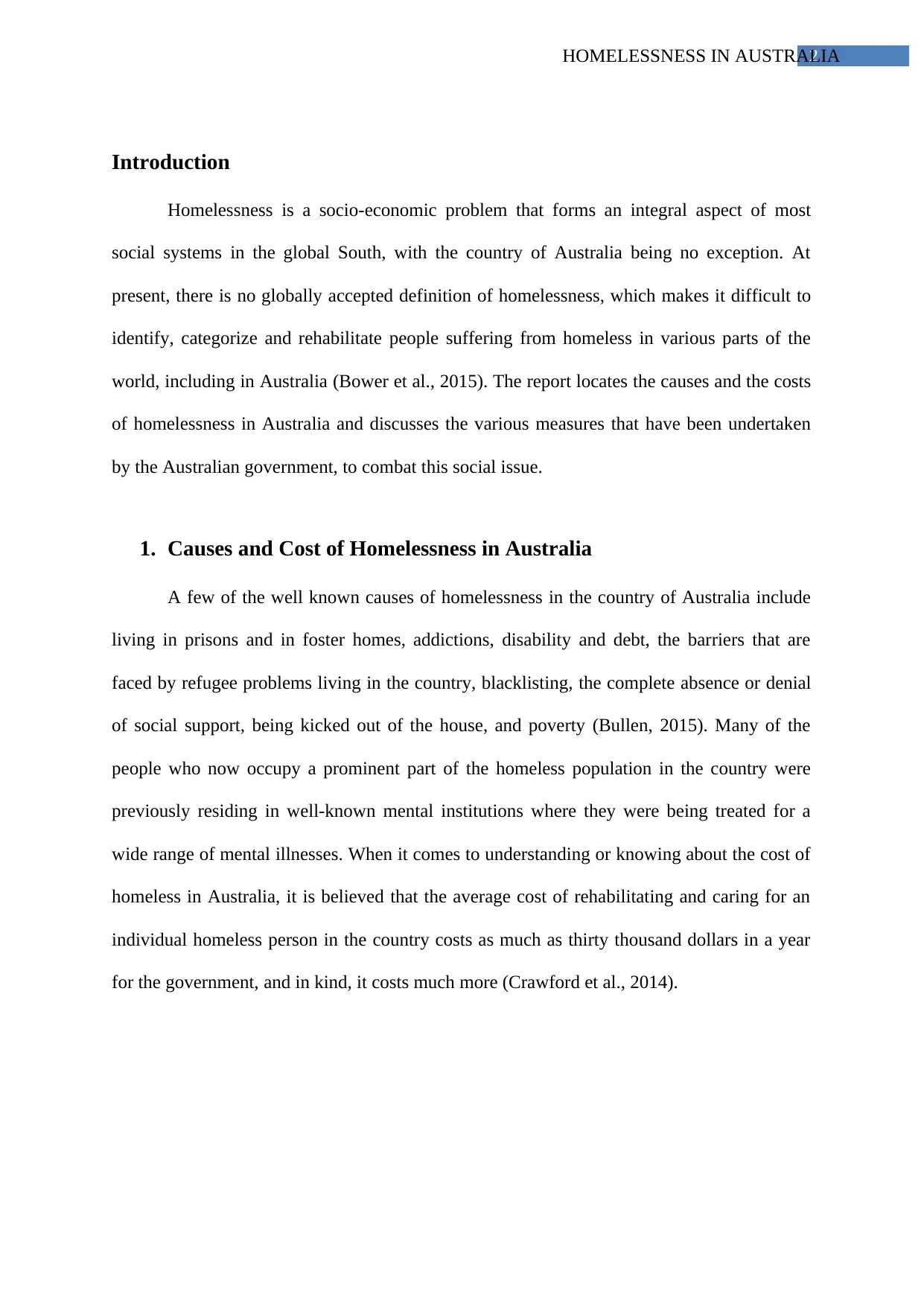
2HOMELESSNESS IN AUSTRALIA
Introduction
Homelessness is a socio-economic problem that forms an integral aspect of most
social systems in the global South, with the country of Australia being no exception. At
present, there is no globally accepted definition of homelessness, which makes it difficult to
identify, categorize and rehabilitate people suffering from homeless in various parts of the
world, including in Australia (Bower et al., 2015). The report locates the causes and the costs
of homelessness in Australia and discusses the various measures that have been undertaken
by the Australian government, to combat this social issue.
1. Causes and Cost of Homelessness in Australia
A few of the well known causes of homelessness in the country of Australia include
living in prisons and in foster homes, addictions, disability and debt, the barriers that are
faced by refugee problems living in the country, blacklisting, the complete absence or denial
of social support, being kicked out of the house, and poverty (Bullen, 2015). Many of the
people who now occupy a prominent part of the homeless population in the country were
previously residing in well-known mental institutions where they were being treated for a
wide range of mental illnesses. When it comes to understanding or knowing about the cost of
homeless in Australia, it is believed that the average cost of rehabilitating and caring for an
individual homeless person in the country costs as much as thirty thousand dollars in a year
for the government, and in kind, it costs much more (Crawford et al., 2014).
Introduction
Homelessness is a socio-economic problem that forms an integral aspect of most
social systems in the global South, with the country of Australia being no exception. At
present, there is no globally accepted definition of homelessness, which makes it difficult to
identify, categorize and rehabilitate people suffering from homeless in various parts of the
world, including in Australia (Bower et al., 2015). The report locates the causes and the costs
of homelessness in Australia and discusses the various measures that have been undertaken
by the Australian government, to combat this social issue.
1. Causes and Cost of Homelessness in Australia
A few of the well known causes of homelessness in the country of Australia include
living in prisons and in foster homes, addictions, disability and debt, the barriers that are
faced by refugee problems living in the country, blacklisting, the complete absence or denial
of social support, being kicked out of the house, and poverty (Bullen, 2015). Many of the
people who now occupy a prominent part of the homeless population in the country were
previously residing in well-known mental institutions where they were being treated for a
wide range of mental illnesses. When it comes to understanding or knowing about the cost of
homeless in Australia, it is believed that the average cost of rehabilitating and caring for an
individual homeless person in the country costs as much as thirty thousand dollars in a year
for the government, and in kind, it costs much more (Crawford et al., 2014).
⊘ This is a preview!⊘
Do you want full access?
Subscribe today to unlock all pages.

Trusted by 1+ million students worldwide
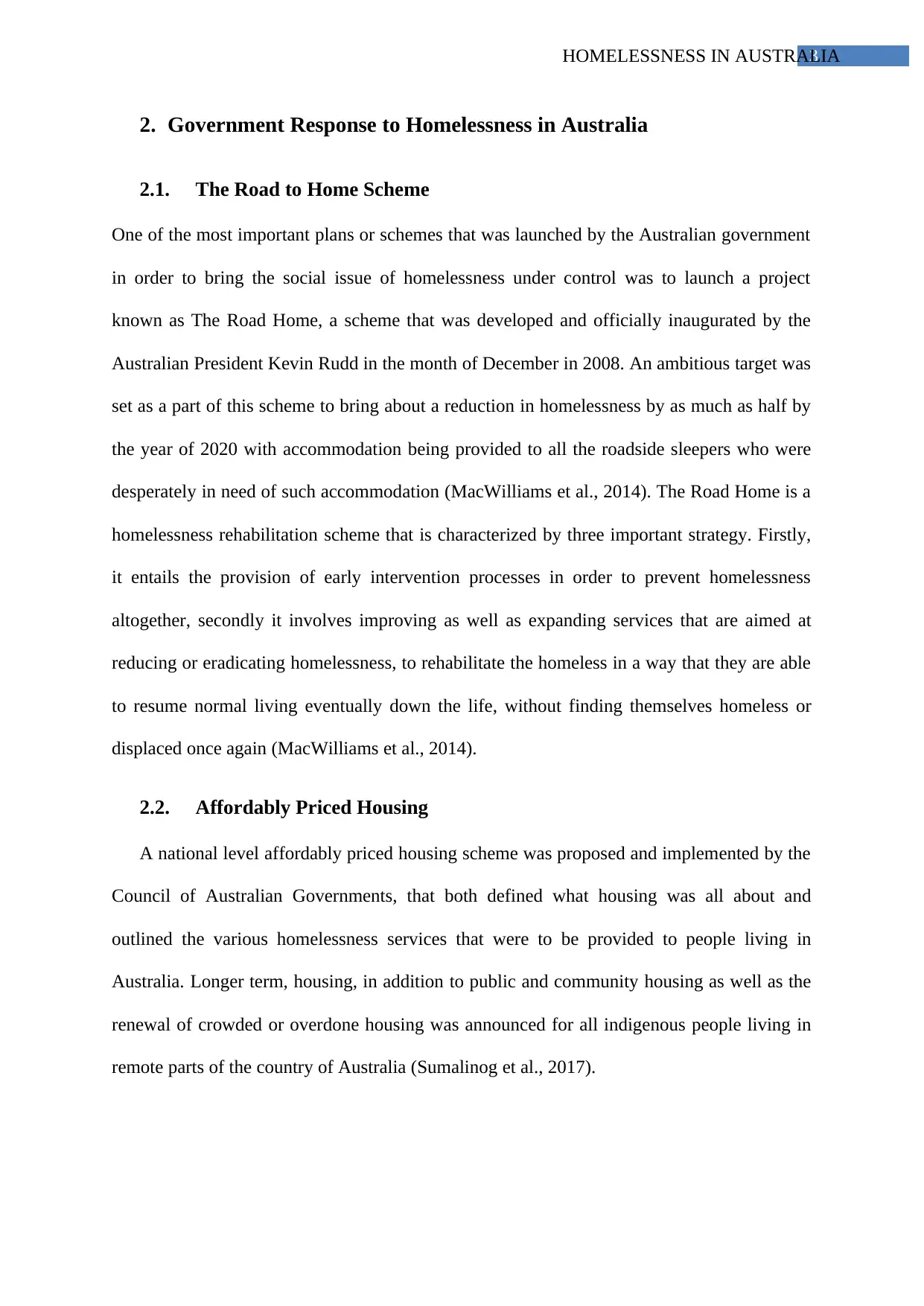
3HOMELESSNESS IN AUSTRALIA
2. Government Response to Homelessness in Australia
2.1. The Road to Home Scheme
One of the most important plans or schemes that was launched by the Australian government
in order to bring the social issue of homelessness under control was to launch a project
known as The Road Home, a scheme that was developed and officially inaugurated by the
Australian President Kevin Rudd in the month of December in 2008. An ambitious target was
set as a part of this scheme to bring about a reduction in homelessness by as much as half by
the year of 2020 with accommodation being provided to all the roadside sleepers who were
desperately in need of such accommodation (MacWilliams et al., 2014). The Road Home is a
homelessness rehabilitation scheme that is characterized by three important strategy. Firstly,
it entails the provision of early intervention processes in order to prevent homelessness
altogether, secondly it involves improving as well as expanding services that are aimed at
reducing or eradicating homelessness, to rehabilitate the homeless in a way that they are able
to resume normal living eventually down the life, without finding themselves homeless or
displaced once again (MacWilliams et al., 2014).
2.2. Affordably Priced Housing
A national level affordably priced housing scheme was proposed and implemented by the
Council of Australian Governments, that both defined what housing was all about and
outlined the various homelessness services that were to be provided to people living in
Australia. Longer term, housing, in addition to public and community housing as well as the
renewal of crowded or overdone housing was announced for all indigenous people living in
remote parts of the country of Australia (Sumalinog et al., 2017).
2. Government Response to Homelessness in Australia
2.1. The Road to Home Scheme
One of the most important plans or schemes that was launched by the Australian government
in order to bring the social issue of homelessness under control was to launch a project
known as The Road Home, a scheme that was developed and officially inaugurated by the
Australian President Kevin Rudd in the month of December in 2008. An ambitious target was
set as a part of this scheme to bring about a reduction in homelessness by as much as half by
the year of 2020 with accommodation being provided to all the roadside sleepers who were
desperately in need of such accommodation (MacWilliams et al., 2014). The Road Home is a
homelessness rehabilitation scheme that is characterized by three important strategy. Firstly,
it entails the provision of early intervention processes in order to prevent homelessness
altogether, secondly it involves improving as well as expanding services that are aimed at
reducing or eradicating homelessness, to rehabilitate the homeless in a way that they are able
to resume normal living eventually down the life, without finding themselves homeless or
displaced once again (MacWilliams et al., 2014).
2.2. Affordably Priced Housing
A national level affordably priced housing scheme was proposed and implemented by the
Council of Australian Governments, that both defined what housing was all about and
outlined the various homelessness services that were to be provided to people living in
Australia. Longer term, housing, in addition to public and community housing as well as the
renewal of crowded or overdone housing was announced for all indigenous people living in
remote parts of the country of Australia (Sumalinog et al., 2017).
Paraphrase This Document
Need a fresh take? Get an instant paraphrase of this document with our AI Paraphraser
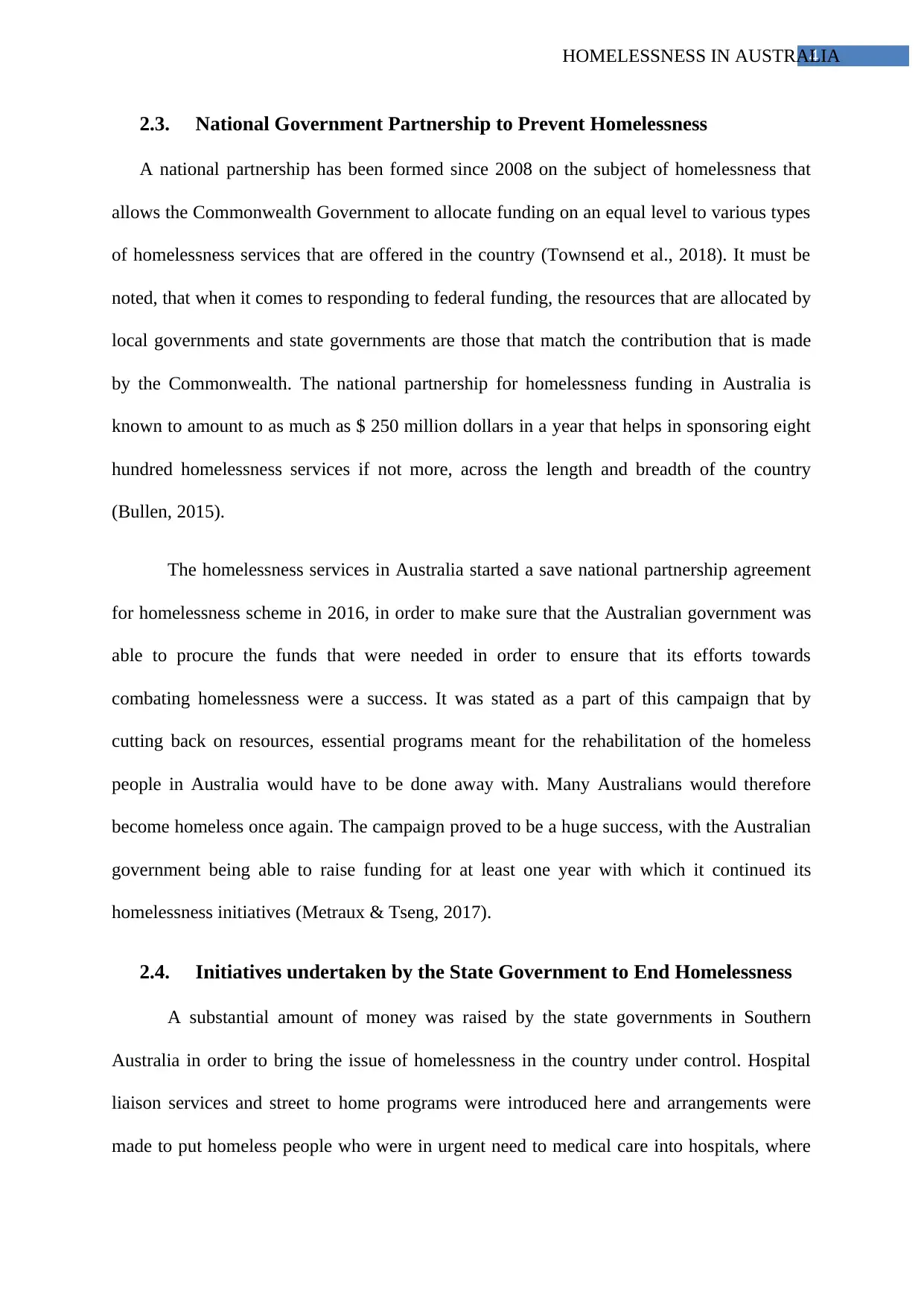
4HOMELESSNESS IN AUSTRALIA
2.3. National Government Partnership to Prevent Homelessness
A national partnership has been formed since 2008 on the subject of homelessness that
allows the Commonwealth Government to allocate funding on an equal level to various types
of homelessness services that are offered in the country (Townsend et al., 2018). It must be
noted, that when it comes to responding to federal funding, the resources that are allocated by
local governments and state governments are those that match the contribution that is made
by the Commonwealth. The national partnership for homelessness funding in Australia is
known to amount to as much as $ 250 million dollars in a year that helps in sponsoring eight
hundred homelessness services if not more, across the length and breadth of the country
(Bullen, 2015).
The homelessness services in Australia started a save national partnership agreement
for homelessness scheme in 2016, in order to make sure that the Australian government was
able to procure the funds that were needed in order to ensure that its efforts towards
combating homelessness were a success. It was stated as a part of this campaign that by
cutting back on resources, essential programs meant for the rehabilitation of the homeless
people in Australia would have to be done away with. Many Australians would therefore
become homeless once again. The campaign proved to be a huge success, with the Australian
government being able to raise funding for at least one year with which it continued its
homelessness initiatives (Metraux & Tseng, 2017).
2.4. Initiatives undertaken by the State Government to End Homelessness
A substantial amount of money was raised by the state governments in Southern
Australia in order to bring the issue of homelessness in the country under control. Hospital
liaison services and street to home programs were introduced here and arrangements were
made to put homeless people who were in urgent need to medical care into hospitals, where
2.3. National Government Partnership to Prevent Homelessness
A national partnership has been formed since 2008 on the subject of homelessness that
allows the Commonwealth Government to allocate funding on an equal level to various types
of homelessness services that are offered in the country (Townsend et al., 2018). It must be
noted, that when it comes to responding to federal funding, the resources that are allocated by
local governments and state governments are those that match the contribution that is made
by the Commonwealth. The national partnership for homelessness funding in Australia is
known to amount to as much as $ 250 million dollars in a year that helps in sponsoring eight
hundred homelessness services if not more, across the length and breadth of the country
(Bullen, 2015).
The homelessness services in Australia started a save national partnership agreement
for homelessness scheme in 2016, in order to make sure that the Australian government was
able to procure the funds that were needed in order to ensure that its efforts towards
combating homelessness were a success. It was stated as a part of this campaign that by
cutting back on resources, essential programs meant for the rehabilitation of the homeless
people in Australia would have to be done away with. Many Australians would therefore
become homeless once again. The campaign proved to be a huge success, with the Australian
government being able to raise funding for at least one year with which it continued its
homelessness initiatives (Metraux & Tseng, 2017).
2.4. Initiatives undertaken by the State Government to End Homelessness
A substantial amount of money was raised by the state governments in Southern
Australia in order to bring the issue of homelessness in the country under control. Hospital
liaison services and street to home programs were introduced here and arrangements were
made to put homeless people who were in urgent need to medical care into hospitals, where
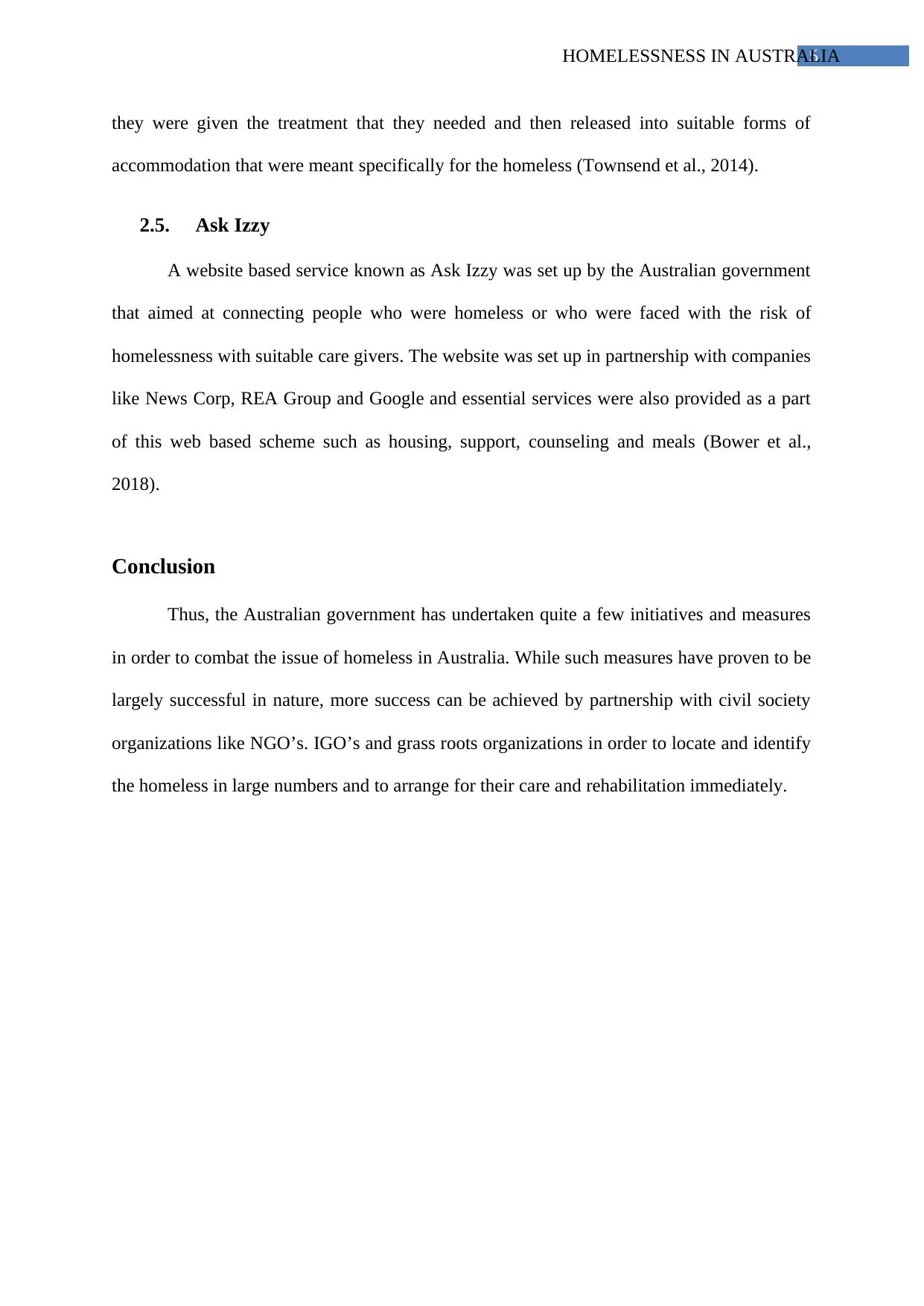
5HOMELESSNESS IN AUSTRALIA
they were given the treatment that they needed and then released into suitable forms of
accommodation that were meant specifically for the homeless (Townsend et al., 2014).
2.5. Ask Izzy
A website based service known as Ask Izzy was set up by the Australian government
that aimed at connecting people who were homeless or who were faced with the risk of
homelessness with suitable care givers. The website was set up in partnership with companies
like News Corp, REA Group and Google and essential services were also provided as a part
of this web based scheme such as housing, support, counseling and meals (Bower et al.,
2018).
Conclusion
Thus, the Australian government has undertaken quite a few initiatives and measures
in order to combat the issue of homeless in Australia. While such measures have proven to be
largely successful in nature, more success can be achieved by partnership with civil society
organizations like NGO’s. IGO’s and grass roots organizations in order to locate and identify
the homeless in large numbers and to arrange for their care and rehabilitation immediately.
they were given the treatment that they needed and then released into suitable forms of
accommodation that were meant specifically for the homeless (Townsend et al., 2014).
2.5. Ask Izzy
A website based service known as Ask Izzy was set up by the Australian government
that aimed at connecting people who were homeless or who were faced with the risk of
homelessness with suitable care givers. The website was set up in partnership with companies
like News Corp, REA Group and Google and essential services were also provided as a part
of this web based scheme such as housing, support, counseling and meals (Bower et al.,
2018).
Conclusion
Thus, the Australian government has undertaken quite a few initiatives and measures
in order to combat the issue of homeless in Australia. While such measures have proven to be
largely successful in nature, more success can be achieved by partnership with civil society
organizations like NGO’s. IGO’s and grass roots organizations in order to locate and identify
the homeless in large numbers and to arrange for their care and rehabilitation immediately.
⊘ This is a preview!⊘
Do you want full access?
Subscribe today to unlock all pages.

Trusted by 1+ million students worldwide
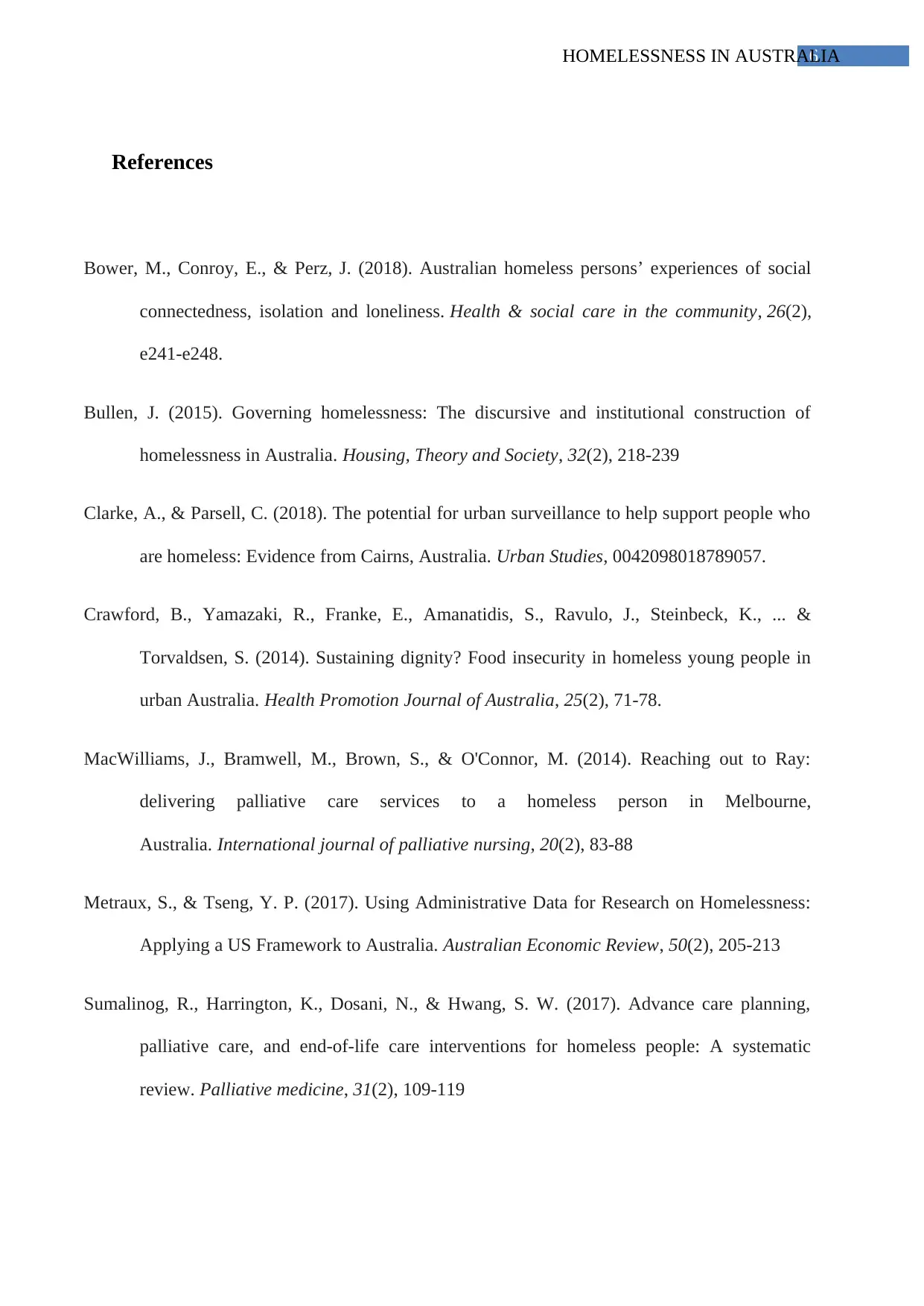
6HOMELESSNESS IN AUSTRALIA
References
Bower, M., Conroy, E., & Perz, J. (2018). Australian homeless persons’ experiences of social
connectedness, isolation and loneliness. Health & social care in the community, 26(2),
e241-e248.
Bullen, J. (2015). Governing homelessness: The discursive and institutional construction of
homelessness in Australia. Housing, Theory and Society, 32(2), 218-239
Clarke, A., & Parsell, C. (2018). The potential for urban surveillance to help support people who
are homeless: Evidence from Cairns, Australia. Urban Studies, 0042098018789057.
Crawford, B., Yamazaki, R., Franke, E., Amanatidis, S., Ravulo, J., Steinbeck, K., ... &
Torvaldsen, S. (2014). Sustaining dignity? Food insecurity in homeless young people in
urban Australia. Health Promotion Journal of Australia, 25(2), 71-78.
MacWilliams, J., Bramwell, M., Brown, S., & O'Connor, M. (2014). Reaching out to Ray:
delivering palliative care services to a homeless person in Melbourne,
Australia. International journal of palliative nursing, 20(2), 83-88
Metraux, S., & Tseng, Y. P. (2017). Using Administrative Data for Research on Homelessness:
Applying a US Framework to Australia. Australian Economic Review, 50(2), 205-213
Sumalinog, R., Harrington, K., Dosani, N., & Hwang, S. W. (2017). Advance care planning,
palliative care, and end-of-life care interventions for homeless people: A systematic
review. Palliative medicine, 31(2), 109-119
References
Bower, M., Conroy, E., & Perz, J. (2018). Australian homeless persons’ experiences of social
connectedness, isolation and loneliness. Health & social care in the community, 26(2),
e241-e248.
Bullen, J. (2015). Governing homelessness: The discursive and institutional construction of
homelessness in Australia. Housing, Theory and Society, 32(2), 218-239
Clarke, A., & Parsell, C. (2018). The potential for urban surveillance to help support people who
are homeless: Evidence from Cairns, Australia. Urban Studies, 0042098018789057.
Crawford, B., Yamazaki, R., Franke, E., Amanatidis, S., Ravulo, J., Steinbeck, K., ... &
Torvaldsen, S. (2014). Sustaining dignity? Food insecurity in homeless young people in
urban Australia. Health Promotion Journal of Australia, 25(2), 71-78.
MacWilliams, J., Bramwell, M., Brown, S., & O'Connor, M. (2014). Reaching out to Ray:
delivering palliative care services to a homeless person in Melbourne,
Australia. International journal of palliative nursing, 20(2), 83-88
Metraux, S., & Tseng, Y. P. (2017). Using Administrative Data for Research on Homelessness:
Applying a US Framework to Australia. Australian Economic Review, 50(2), 205-213
Sumalinog, R., Harrington, K., Dosani, N., & Hwang, S. W. (2017). Advance care planning,
palliative care, and end-of-life care interventions for homeless people: A systematic
review. Palliative medicine, 31(2), 109-119
Paraphrase This Document
Need a fresh take? Get an instant paraphrase of this document with our AI Paraphraser

7HOMELESSNESS IN AUSTRALIA
Townsend, C., White, P., Cullen, J., Wright, C. J., & Zeeman, H. (2018). Making every
Australian count: challenges for the National Disability Insurance Scheme (NDIS) and
the equal inclusion of homeless Aboriginal and Torres Strait Islander Peoples with
neurocognitive disability. Australian Health Review, 42(2), 227-229.
Townsend, C., White, P., Cullen, J., Wright, C. J., & Zeeman, H. (2018). Making every
Australian count: challenges for the National Disability Insurance Scheme (NDIS) and
the equal inclusion of homeless Aboriginal and Torres Strait Islander Peoples with
neurocognitive disability. Australian Health Review, 42(2), 227-229.
1 out of 8
Related Documents
Your All-in-One AI-Powered Toolkit for Academic Success.
+13062052269
info@desklib.com
Available 24*7 on WhatsApp / Email
![[object Object]](/_next/static/media/star-bottom.7253800d.svg)
Unlock your academic potential
Copyright © 2020–2025 A2Z Services. All Rights Reserved. Developed and managed by ZUCOL.





